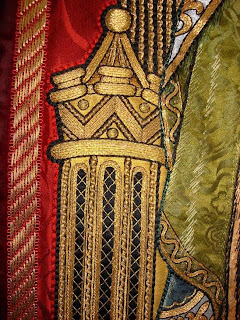 It's always interesting to see how others have done something, and when it comes to processional banners, they don't come any better than this.
It's always interesting to see how others have done something, and when it comes to processional banners, they don't come any better than this. I went for a visit to York Minster recently, to have a look at some of their ecclesiastical embroidery. I was fortunate to be able to speak to two very knowledgeable ladies from the York Minster Broderers, who gave me a tour of the embroideries on public display, and some very useful hints and tips.
York Minster is currently undergoing extensive restoration work, and a lot of their textiles are in storage while the building work is carried out, so I was unable to see a series of contemporary processional banners made in the 1990s, but I was able to see this, the star of the show, and one of the finest pieces of early 20th century embroidery in the country.
The descriptively-named Great Processional Banner is an absolutely fabulous piece of craftsmanship. Dedicated in 1916, this was made by Watts & Co in London, and there must be months if not years of work in it.
It's huge - about 8 feet long by 4 feet wide, and takes two strong men to carry. There's a lot of beautiful goldwork - couched gold thread - involved, but I was particularly interested to have the chance to examine the other techniques used. The faces are exquisitely worked in silk in long and short stitch and split stitch, giving a marvellous expressive effect, as in this image of St Cuthbert.

A lot of it, though, is appliqué embellished with embroidery. In this detail of St Peter's robe, you can see that it's made of green damask applied to the background, with some quite large stitches in shades of green onto it, to give the effect of folds.
As I'm planning on using goldwork, appliqué and split stitch myself on St Cuthbert's Banner, I was fascinated to see how this was done. I was especially interested to see the size of some of the stitches, which were an inch or so long. I often work at quite a small scale, which I enjoy, but there are some cases when stitches that can be measured in millimetres aren't necessarily appropriate. When working on a piece that's designed to have an impact when viewed from the back of a cathedral, you can go a little larger!






No comments:
Post a Comment